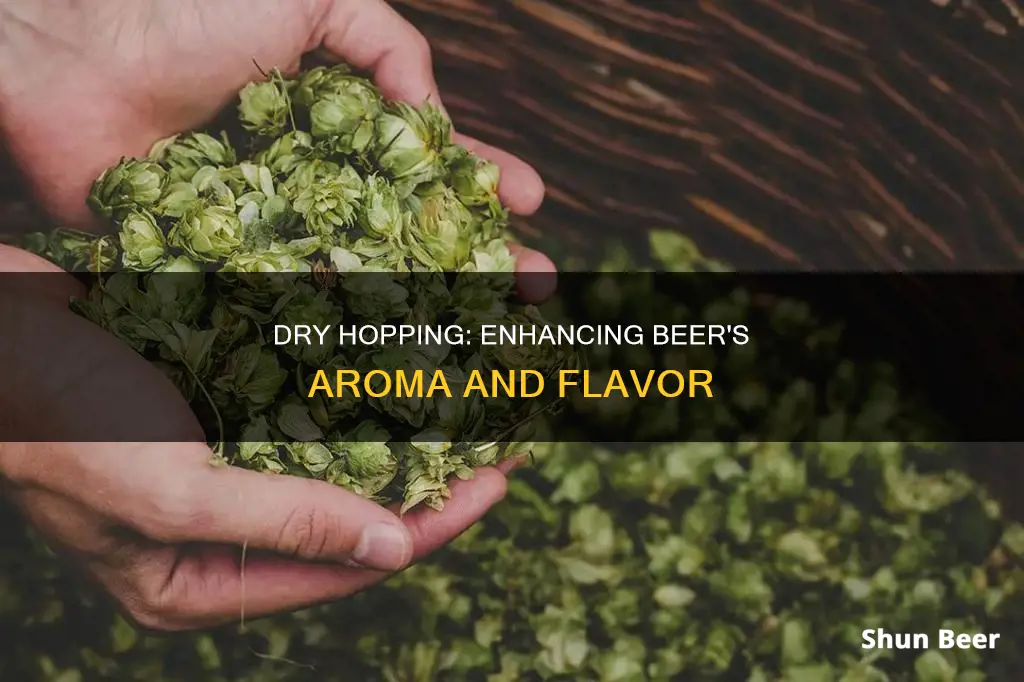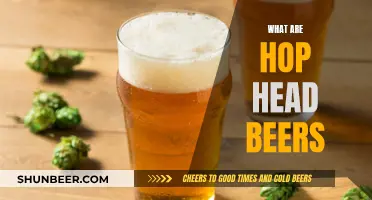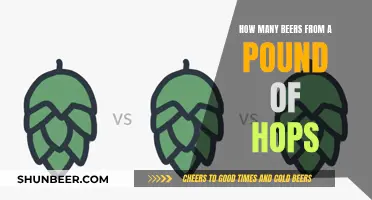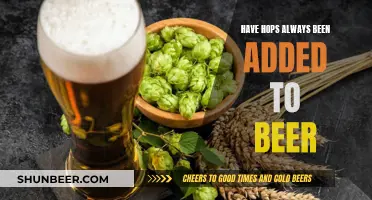
Dry hopping is a brewing technique used to enhance the aroma and flavour of beer without increasing its bitterness. The process involves adding hops during the fermentation or conditioning phase, or even directly to the cask or keg. Dry hopping is typically done for beer styles like pale ales and IPAs, but brewers are increasingly experimenting with dry hopping in other styles as well.
| Characteristics | Values |
|---|---|
| Purpose | To infuse beer with additional fresh hop flavor and aroma |
| Technique | Cold infusion |
| Timing | Late in the brewing process, during or after primary fermentation |
| Container | Fermentation or conditioning tank, or cask |
| Temperature | Warmer temperatures result in faster aroma transfer |
| Contact Time | Extended contact time may result in an unpleasant grassy or oily flavor |
| Form of Hops | Dried whole leaf, pellets, plugs, or loose |
| Amount of Hops | No standard amount, but typically between 1-2 oz. for a five-gallon batch |
What You'll Learn

Dry hopping adds aroma and flavour to beer without bitterness
Dry hopping is a technique used by brewers to enhance the aroma and flavour of beer without adding bitterness. It involves adding hops late in the brewing process, usually during fermentation or conditioning, or even after fermentation has finished. This is known as a "cold side" addition, as it occurs when the beer moves from the kettle to the fermentation tanks, and results in a more intense hop character.
The purpose of dry hopping is to infuse beer with additional fresh hop flavour and aroma. It is a cold infusion technique that intensifies hop aromatics and adds aromatics that are different from those achieved by late hopping, where hops are added during the boil. During the boil, the highly volatile hop oil components escape with the steam, taking the aromatics out of the wort. While late hopping can restore some essential oils, dry hopping is more effective at infusing these oils into the beer.
The benefit of dry hopping is that the brewer can maximise the flavour and aroma in the final beer. This technique can give the beer a floral hop essence and an intense flavour that is desirable in hoppy beer styles like pale ales and IPAs. By adding hops after the wort has been cooled, brewers can preserve the volatile oils that produce flavour and aroma, which would otherwise boil out of the wort within 15-20 minutes. These oils do not survive a boil, so dry hopping helps to preserve them.
While dry hopping can increase the bitterness perception of beer, it does not add bitterness. The alpha acids in hops that create bitterness are isomerized when heated during the boil, and boiling is necessary to convert these acids to iso-alpha acids, which create bitterness. Since dry hopping does not involve boiling the hops, these alpha acids remain insoluble, and thus do not contribute bitterness to the beer.
Dry hopping is a popular technique in craft brewing, particularly in American IPAs and English pale ales, as it allows brewers to supercharge the hop character so that it stands out in the finished beer.
Hops' Role in Extending Beer's Shelf Life and Stability
You may want to see also

It's a cold infusion technique, usually done during fermentation
Dry hopping is a cold infusion technique, usually done during fermentation, that adds hops to beer to enhance its flavour and aroma. The process involves adding hops to the beer after primary fermentation, releasing essential oils from the hops, which enhances the flavour and aroma without increasing bitterness.
Dry hopping is typically done in fermentation tanks, where hops are added late in the brewing process to increase specific aromas and flavours without extracting the bittering qualities of the hops. This technique is often used to create "'hop-forward' beers, such as IPAs, where the hops are the prominent flavour and aroma.
The temperature during dry hopping is an important consideration. Brewers can choose to dry hop at warmer temperatures, typically 70°F (21°C) or above, or at colder temperatures, starting around 58°F (14°C) or lower. Warmer temperatures can help fight off "hop creep", as the yeast is still active and can clear any issues. Colder temperatures, on the other hand, can lead to a more drinkable beer as the greener, more astringent compounds in hops extract less efficiently, resulting in a smoother flavour profile.
The contact time for dry hopping is also crucial. While traditional methods suggest a week at room temperature, modern brewers often opt for shorter durations, with some recommending as little as 24 hours. Over-extracting hops can lead to harsher, greener flavours that can negatively impact the beer. Brewers must also consider the quantity of hops used, which will depend on the type of beer being made and the equipment available.
Dry hopping is a popular technique because it adds a unique character to the beer, enhancing its aroma and flavour. It is a valuable tool for brewers, allowing them to create bold and expressive beers that stand out on the shelf.
Stout Beers: Hops, Their Presence and Purpose
You may want to see also

It's often used for pale ales and IPAs
Dry hopping is often used for pale ales and IPAs because it gives the beer a floral hop essence and an intense flavour that is desirable in hoppy beer styles. The technique is used to supercharge hop character so it leaps from the beer you're drinking.
The process involves adding hops late in the brewing process, usually during fermentation or conditioning, to ramp up specific aromas and flavours without extracting the bittering qualities of hops. Hops contain compounds called alpha acids, which, when heated during the boil, undergo isomerisation to provide hop bitterness in the beer. Boiling hops for longer leads to more isomerisation and a more bitter finished beer.
Dry hopping preserves the delicate volatile oils that produce flavour and aroma and will give your beer that much-desired mouth-watering aroma. These oils do not survive a boil. The technique is particularly suited to pale ales and IPAs because it gives the beers a bright, hoppy character. However, this character has a relatively short life and will start to degrade within a few months.
The origin of dry hopping is often erroneously tied to the IPA exclusively. The mythologised IPA tale explains how English brewers boosted the strength and hops of their pale ales to help them survive the long ship ride to India, with dry hopping contributing to that boost. However, historian Ron Pattinson points out that this is an oversimplification. He believes that dry hopping predates the IPA and was originally used for all beers, not just those for export. By the first half of the 19th century, it was mostly limited to pale ales, but some brewers still dry-hopped all their beers.
Hops in Beer: Healthy or Harmful?
You may want to see also

It's done late in the brewing process, after the wort has been cooled
Dry hopping is done late in the brewing process, after the wort has been cooled. This technique is used to add aroma and flavour to the beer without increasing its bitterness. The hops are added during the cold side of the brewing process, when the beer is in the fermentation tanks.
The benefit of adding hops at this stage is that the volatile oils in the hops, which are responsible for the aroma and flavour, are preserved. During the hot side of the brewing process, when the wort is boiled, these oils boil out of the wort and are lost. By adding hops after the wort has cooled, brewers can get the most flavour and aroma into the final beer. This technique can give the beer a floral essence and an intense flavour that is desirable in hoppy beer styles like pale ales and IPAs.
There are several methods for dry hopping. The most common approach is to fill nylon bags with hops and suspend them inside the fermentation tanks. However, this method can be tricky as the bags tend to float to the top of the tank. Another method is to use a custom device called a Hop Torpedo, which circulates the beer out of the fermentation tank and through a column of hops before flowing back into the tank. Brewers can adjust the time, temperature, and speed of circulation to control the aromas and flavours in the finished beer.
Dry hopping can also be done in the primary or secondary fermenter, or directly in the keg. When dry hopping in the primary or secondary fermenter, it is common to use a bag to contain the hops, although some brewers prefer to let the hops roam free in the beer for better contact and overall aroma. When dry hopping in the keg, it is important to use a bag to contain the hops to prevent them from being sucked into the system and causing clogs.
The type of hops used for dry hopping can vary, but it is common to use aroma-forward hops such as Cascade, Centennial, Amarillo, and Simcoe for West Coast/American IPAs, or Citra, Mosaic, and Galaxy for tropical NEIPAs. The amount of hops used will depend on the desired intensity of the aroma and flavour, but a typical measurement for dry hopping is between 1-2 oz of hops for a five-gallon batch.
Apple Cider Beer: Hops or No Hops?
You may want to see also

It's a process that originated in Britain
Dry hopping is a process that involves adding hops to beer during the fermentation or conditioning stage of the brewing process. It is called dry hopping because the hops are added to the beer in their dry form and are not boiled in the wort. This process originated in Britain and was first used by British brewers in the 18th and 19th centuries. The most common hypothesis is that it was invented by George Hodgson of the Bow Brewery in East London.
Dry hopping is done to infuse beer with additional fresh hop flavor and aroma. The purpose is to extract as many hop essential oils as possible, which are largely lost during the standard hopping process. The process can be carried out in a cask, barrel, or fermenting/conditioning tank. Hops can be added in the form of whole flowers or hop pellets. Whole flowers are traditional but can be difficult to work with as they float vigorously and are hard to keep submerged in the beer.
Dry hopping is commonly used for English pale ales and their variants. It is also widely used in American craft brewing, where it is associated with intense dry hop character and is considered a quintessentially American attribute when it comes to beer flavor.
Hops-Free Brews: Exploring the World of Hopless Beers
You may want to see also
Frequently asked questions
Dry hopping is a brewing technique where hops are added to beer late in the brewing process, usually during fermentation or conditioning, to enhance its aroma and flavour without increasing bitterness.
Dry hopping is done when the beer is on the "cold side", i.e. after the kettle boil. This prevents the bitter resins and oils in the hops from boiling out, allowing the beer to retain its aroma and flavour.
Dry hopping adds aroma and flavour to beer, without increasing bitterness. It can give beer a floral essence and an intense flavour desirable in hoppy beers like pale ales and IPAs.
Dry hopping is done late in the brewing process, usually during fermentation or conditioning, and after the wort has been cooled.







